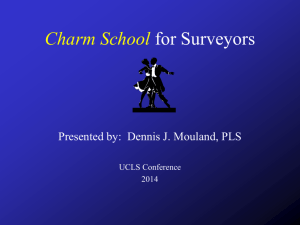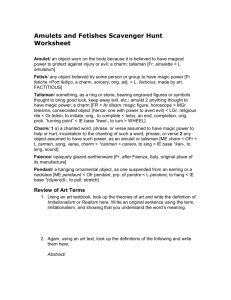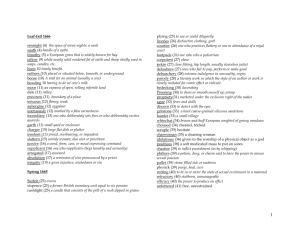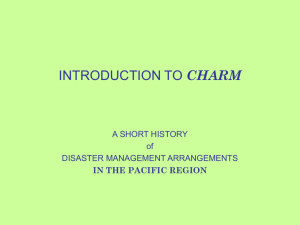Heavy Quark Partons and Global QCD Analysis Wu-Ki Tung
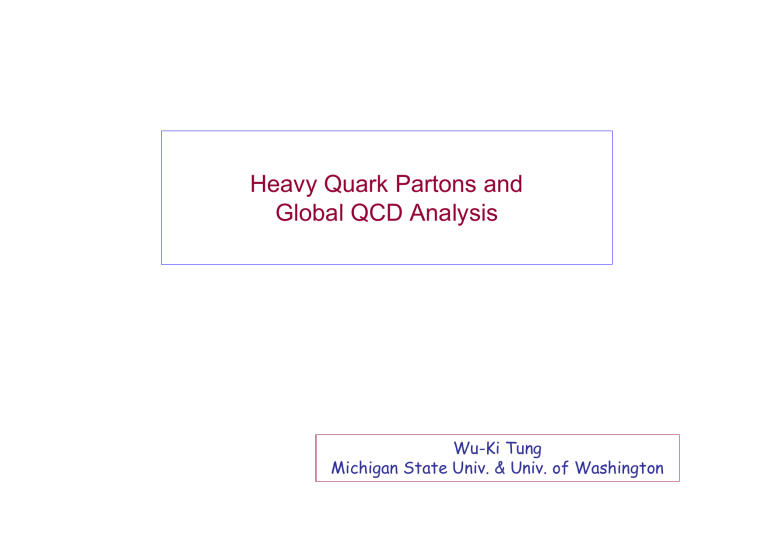
Heavy Quark Partons and
Global QCD Analysis
Wu-Ki Tung
Michigan State Univ. & Univ. of Washington
Outline
• Heavy Quark Parton? An oxymoron?
• A general PQCD formalism for Heavy Quark Parton masses in high energy scattering (85 – 98) with
precise and efficient implementation (new).
• Global QCD Analysis:
What are the challenges in the era leading to LHC?
• Application I: New global analysis, based on (i) the new implementation of HQ effects, and (ii) the full HERA I total and semi-inclusive cross section data sets with correlated errors;
• Application II: First phenomenological study of the heavy quark
(charm) degrees of freedom in the structure of the nucleon.
• Summary and Outlook
The Heavy Quark Parton Dichotomy
• Heavy quarks (c,b,t) as partons (Zero Mass VFNS):
Parton Distributions (D-O/EHLQ/ … /MRST/CTEQ)
Event Generators (Pythia/Herwig/ … )
Most calculations on high energy SM and New Physics signals and backgrounds in the literature.
• Clearly not an appropriate description when Q~M.
• Theoretical Calculations of Heavy quark Production:
(Fixed-flavor-number scheme, FFNS)
-
E.g. for bottom prod., b b , g b b g , …
• Becomes singular (IR unsafe) as Q>>M (~ s n ln n (Q/M) ).
Dichotomy Resolved: PQCD with massive partons
ZM 4-flavor scheme
84 debates at Snowmass;
85 (Collins-wkt): there is a place for HQ ’
3-flavor scheme, with HQ mass
General Formalism of
Collins ‘ ‘
— Composite Scheme with HQ masses .
Physics of Heavy Quark Partons in General PQCD
E.g. charm prod. in DIS
For Q~M : 3-flavor scheme
(no charm parton)
For Q>M : 4-flavor scheme
(with heavy quark parton — with M
H
+
The composite scheme describes the correct physics at all scales — from threshold to the asymptotic limit Q>>M
H
.
Physics of Heavy Quark Partons in General PQCD (ACOT)
E.g. charm prod. in DIS
Start with Q ~ M: basic mechanism is, gluon fusion
3-flavor scheme
(no c parton)
gluon fusion
Physics of Heavy Quark Partons in General PQCD
E.g. charm prod. in DIS start with Q ~ M
At high energies
~ Q >> M
H
, s
(Q)ln(Q/M) ~ 1 because of the colinear region of final state phase space: colinear, infra-red unsafe
PQCD breaks down!
Must subtract these “ ” terms to restore IRS.
Physics of Heavy Quark Partons in General PQCD
E.g. charm prod. in DIS start with Q ~ M gluon fusion
s
Q >> M
H ln(Q/M)~1
Finite mass-dependence; no more singularities.
^
IRS “ ” colinear, infra-red unsafe
Can ’ term that one does not like !
Must put it back in, and systematically control these singular terms: “ ” it, together with similar unsafe terms to all orders, yielding the universal charm PDF!
Physics of Heavy Quark Partons in General PQCD
E.g. charm prod. in DIS start with Q ~ M
s
Q >> M
H ln(Q/M)~1
NLO corr.
^ resum to all orders:
c PDF
4-flavor scheme
— with c parton; important to include c mass in final state for correct kinematics (rescaling).
LO c prod.
at high E
Close the circle:
How does the resummed calculation do back in the threshold region (where we started)?
Physics of Heavy Quark Partons in General PQCD
E.g. charm prod. in DIS
“ ” c prod.
~ threshold
Return to 3-flavor scheme result, with some higher order corrections.
Q ~ M
H ln(Q/M)~1 not large
0 + O( s
2 )
We arrive at a general formalism that is valid over the entire range of Q, from threshold to high energies!
Typical Results: F
2 c
Some Theoretical Features of the General Formalism
Collins, Wilczek, Zee ‘
The assumption M=0 is convenient, but not necessary.
Implementation of the General Formalism
• Needs more than just the formalism to make reliable calculations:
Choices to be made within PQCD: Renorm. & fact.
scales; matching/transition points for the composite scheme calculation;
Proper (and consistent) treatment of the kinematics of light/heavy partons, as well as produced hadrons.
• Incremental improvements make, ’ – now .
New elements of the 2006 implementation:
Proper differentiation between incoming parton
(scheme-dep) and final-state HQ (on mass shell);
“ ” treatment of kinematics — important to introduce rescaling variable.
• The new package is comprehensive, consistent, and surprisingly simple (hence efficient).
universal extracted by global analysis
,
Theory
Input
Challenges for Global QCD Analysis
— from here to LHC
In spite of steady progress in over 20 years of global analysis of PDFs, it is surprising how much knowledge is still missing on the parton structure of the nucleon !
• Gluon Distribution;
• Small-x and Large-x behavior of all distributions;
• Strange distribution;
• Charm and bottom distributions;
• Quantifying uncertainties of all PDFs.
The success of the Tevatron Run II and the LHC physics programs depends on making substantial improvements on most of these fronts.
Uncertainties of PDFs:
Q 2 = 10 GeV 2
CTEQ6 by an iterative
Hessian method, using orthonormal eigenvector sets
Theory uncertainties not explicitly included; but some allowance is made in the tolerance.
New Experimental Input to Current Global Analysis
• Extensive HERA I data sets (complete?) on
total inclusive NC and CC cross sections, covering a wide range of kinematic phase space;
semi-inclusive (tagged heavy flavor) cross sections: charm and bottom;
semi-inclusive jet cross sections.
• (Note: out go the SFs, F
1,2,3
; in come the xSec ’
• Fixed-target Experiments (Last of the kind?)
NuTeV DIS S.F.s and cross sections;
E866 DY pp and pd cross sections (finally?).
• New Tevatron Data on W/Z production, jet production, … etc.
Available HERA Data Sets for Current Global Analysis
• H1
CCe+9497X
CCe+9900X
CCe-9899X
NCe+9497X
NCe+9900X
NCe-9899X
NCe-9900X
NCe+9697F
2 c
NCe+9900Xc
NCe+9900Xb
• ZEUS
CC+9497X
CC+9900X
CC-9899X
NC+9697X
NC+9900X
NC-9899X
NC+9697F
NC+9890F
2 c
2 c
HERA II data are beginning to emerge. (DIS2006) Precision will improve considerably more.
Progress on the Theoretical Foundation of Global QCD Analysis
Not discussed in this talk:
• NNLO evolution and hard scattering cross section calculations;
(Much publicized; but how important?)
• Resummations in multi-scale problems
(small-x, large-x, p t
, … );
• Power-law Corrections.
(Their days have finally arrived?)
(aka Higher-twist, Renormalons, … etc.)
Focus on:
• The new implementation of the general PQCD formalism described earlier in this talk.
(NB. This also represents a resummation of multi-scale problem — Q and M
H
.)
When and where do mass effects matter?
• In the kinematic phase space:
When the rescaling variable is different from x, and where f(x,Q) is steep in x
NC: Kretzer, Schmidt, wkt (cf. CC: Barnett)
• For Physics quantities that vanish in the zero-mass limit, such as LO F longitudinal
.
(skip)
• In real-life precision phenomenology:
Certain HERA data sets — in the low Q 2 region
(skip)
Comparison of
GM and ZM
Calculations: where in the
(x,Q) plane do the differences matter?
F
2
(x,Q) low Q 2 mostly
GM ZM
Applications of the New Implementation of the
GM calculation
• In conjunction with the comprehensive HERA I data
(+ Fixed Target and Hadron Collider data), the new
GM calculation
Precision global QCD analysis of PDFs
• First phenomenological study of the heavy flavor parton distributions:
Is there room for intrinsic charm in the nucleon?
If yes, how much?
• Collaborators: Belyaev, Lai, Pumplin, Stump, Yuan
• (MSU)
New Precision Global Analysis
• Excellent fit to 32 sets of data — CTEQ6C0;
(representative plots.)
• Comparison of CTEQ6.1M and CTEQ6C0 PDFs;
(representative plots)
• Where do mass effects matter in the global analysis?
— low Q2 data.
H1
NC e+ 96-97 X (
ZEUS
NC e+ 99-00 X ( *-Z interference)
H1
Zeus
Comparison to
CC data
(W-exchange)
Lines: theory (fits);
Red points : raw data points;
Blue points : data points shifted by optimal correlated SysErr.
(usually within 1 )
H1 CC e+ 99-00 X
Where does the General Mass Formalism make a difference? Compare with CTEQ6.1M (ZM)
Low Q 2 bins, of course.
GM
H1 96-97
ZM
ZEUS 96-97 data show the same effects
Comparison of New PDF (CTEQ6C0) with previous PDFs (CTEQ6.1 and its uncertainty band)
• Space only permit a very brief comparison: Gluon at two scales
• New PDFs lie within the previously estimated uncertainty bands.
• After a new round of careful study, the new uncertainty bands should be narrower, due to improvements on both theory and experiment.
The Charm Content of the Nucleon
Why should we care about c(x,Q)?
Intrinsic interest: the structure of the nucleon;
Practical interests: collider phenomenology, especially beyond the SM, e.g.
• Charged Higgs production, c + s-bar --> H + ;
• Single top production in DIS (flavor-changing NC) …
• Conventional global analysis assume that heavy flavor partons are exclusively generated “ gluon splitting.
radiatively ”
• This assumption/ansatz more or less existing data on production of charm.
agrees with
•“ ” since: (i) experimentally, errors on data are large ; and (ii) theoretically, the ansatz is ambiguous: at what scale does the radiation start ?
Is there a non-perturbative charm component in the nucleon; and if so, how big can it be?
Theoretical preconceptions aside, let nature speaks for herself:
Perform unbiased global analysis, allowing charm to have its own degrees of freedom, in two scenarios:
A sea-like component at some initial scale Q
0
;
A light-cone model component (centered at moderate x) — aka intrinsic charm ” (championed by you-know-who!).
(A hybrid model is also possible, but clearly there is not enough experimental constraints yet to warrant a separate study.)
Method: (i) For various assumed input charm c(x,Q ) by the currently used c(x,Q independent global fits, and compare the resulting goodness-of-fit, global
0 uncertainties.
; (ii)
0
) , do
Define the range of allowed
2 global for defining PDF
A little bit of detail
Since current experimental constraints are rather loose, we must limit the new degrees of freedom:
• For the sea-like scenario, assume the shape of c(x,Q ) is the same as s(x,Q ) and only vary the normalization;
0
• For the light-cone model scenario, take the shape of c(x,Q ) to be that of Brodsky etal, and only vary the
First results on the non-perturbative charm content of the nucleon …
Goodness-of-fit vs. input non-perturbative
Charm momentum fraction
The appropriate value for in the current global analysis environment has not yet been investigated. Hence, the value for the allowed charm mom. frac. should be taken as indicative only.
Parton Distributions in the presence of a nonzero component of charm
• Charm Distribution
@ Q
0
, Q 2 = 10 GeV, Q = 85 GeV & for Scenarios B — light-cone like charm component.
• Gluon Distribution
(same as above)
• Not shown due to lack of space:
Strange Distribution;
Ubar+dbar Distribution.
(these can be affected by the charm content in scenario A — the sea-like input charm tied to the light flavors)
Charm and Gluon Distributions at Q = 1.3 GeV
Varying amounts of input lightcone charm components
(à la Brodsky etal.) : Momentum frac. at Q
0
= 0 — 0.02.
Horizontal axis is scaled in x 1/3 — inbetween linear and log — in order to exhibit the behavior at both large and small x.
Charm and Gluon Distributions at Q
2
= 10 GeV
2
Varying amounts of input lightcone charm components
(à la Brodsky etal.) : Momentum frac. at Q0 = 0 — 0.02.
* Two-component charm distr. is apparent! (The radiatively generated component is represented by C6C0l (black) curve.
Charm and Gluon Distributions at Q
2
= (85 GeV)
2
Varying amounts of input lightcone charm components
(à la Brodsky etal.) : Momentum frac. at Q0 = 0 — 0.02.
* Very substantial amount of charm, over the radiatively generated component (C6C0l), still persists at this very large scale there can be interesting phenomenological consequences even at LHC.
Summary and Outlook
• The impressive consistency between the improved theoretical calculation and much improved experimental input on DIS NC,
CC & heavy flavor production (and other F.T. and hadron collider processes) provides a new basis for performing precision phenomenology within and beyond the SM.
• A lot of work remains to be done to pin down the full parton structure of the nucleon (particularly gluon, s, c, b);
• HERA II and Tevatron Run II data can contribute substantially to fill the gaps. More specifically,
• With more accurate data on CC cross sections, we gain additional (clean) handles for differentiating up and down types of quarks;
• Direct F
Long measurement in the cards?
• With W/Z/ + tagged heavy flavor events at the hadron colliders, we can get direct information on s/c/b quark distributions;
•… .
LHC physics is waiting for these advances …
?
Comments on NNLO
• In the perturbative approach, for the total inclusive S.F.s and cross sections, once a comprehensive NLO calculation is in place, it is straightforward to include known NNLO corrections additively.
• Is NNLO analysis necessary?
Main motivations for NNLO analyses advanced by Proponents:
Possible instability of NLO global analysis;
Differences between the NNLO and NLO results are notable at small-x.
• Are these motivations sound?
NLO global analysis is stable.
( Instability ” most probably caused by spurious sources.)
When differences between the NNLO and NLO results are large near the boundary of the phase space, the proper approach is to resum the large logs!
Several recent work on Small-x Resummation confirm this observation — the resummed anomalous dimension is closer to the NLO result! (DIS2006)
Comments on NNLO … continued
• Extending global analysis to NNLO is desirable for certain special processes, but not urgent for the vast majority of current applications (cf. excellent global fits), since experimental errors for most measured quantities, as well as other sources of uncertainties (such as parametrization, power-law corrections … ), largely outweigh the NNLO corrections.
• Moreover, one needs to realize that, unlike total inclusive F quantities such as ” talk about a true “
2 c
2,L and beyond. (It is not infra-red safe !) It is rather misleading to
NNLO theory ” of F
2 c (except within the 3-flv scheme, which has only a limited range of applicability).
,
” is not well defined theoretically at NNLO
?
gluon fusion colinear, infra-red unsafe
Physics of Heavy Quark Partons in General PQCD
E.g. charm prod. in DIS
s
Q >> M
H ln(Q/M)~1 start with Q ~ M
4-flavor scheme
(with c mass in final state)
“ ” c prod.
3-flavor scheme
(no c parton)
NLO corr.
^
Return to 3-flavor scheme result, with some higher order corrections.
Q ~ M
H ln(Q/M)~1 resum to all orders:
c PDF
0 + O( s
2 )
LO c prod.
at high E
